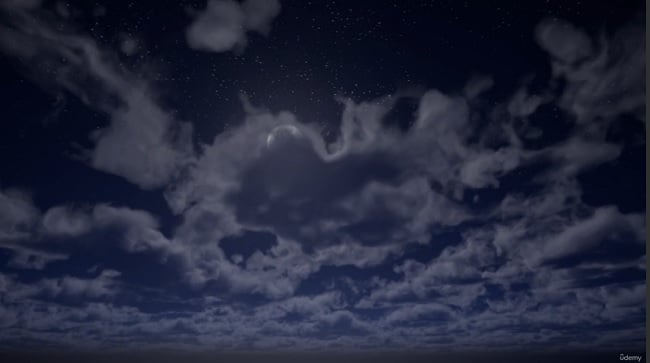
Duration 13h 30m Project Files Included MP4
Unreal Engine 5:One Course Solution For Sky & Weather System
Info:
What you’ll learn
Dynamic sky system with drag and drop lighting solution
Multiple sky presets with corresponding weather
Nighttime sky with moon and stars
Cell bombing and Tri-planar projection material
Different Footstep FX with physical material
Build different Niagara Weather VFX
Write custom Niagara module script for advanced particle behavior
Learn the best coding practices for Material/Niagara/Blueprint
Build beautiful Volumetric Cloud material
Deep dive of different properties for lighting
Create decal materials for weather system
Animate weather FX through blueprint and material parameter collection
Welcome to your ultimate solution for Unreal Engine 5’s Dynamic Sky and Weather System. In this course, you’ll embark on a journey to create a robust sky system featuring a dynamic day-night cycle, mesmerizing volumetric clouds, immersive snowy weather complete with footprints and intricate snow particles, and even rainy weather with lifelike raindrops, puddles, and captivating lightning effects. Best of all, we’ll be starting from the ground up.
In the first section, we’ll delve into creating the fundamental day-night cycle. We’ll bring stars, the moon, and detailed variables into play, enabling us to fine-tune the appearance of our sky system. Our journey begins with crafting a Blueprint Dynamic Sky Actor, offering a streamlined lighting solution. From there, we’ll employ the construction script to lay the foundations of a basic time-of-day system using Blueprint macros. As we progress, we’ll explore the concept of a sky sphere and a sky material, introducing our own customizable stars and moon through blueprint variables.
Moving on to the second section, we’ll introduce 2D clouds and volumetric clouds to our dynamic sky system. This adventure starts with creating a Blueprint enum to define distinct cloud modes. We’ll then enhance our sky material, built in the previous section, to incorporate 2D clouds seamlessly. Additionally, we’ll delve into planar projection, uncovering its role in projecting volumetric clouds onto the sky. We’ll explore volume texture and volumetric advanced output for heightened realism and harness normalized altitude masks and macro variations for intricate detail and captivating shapes. After breathing life into our clouds with animations, we’ll expose more properties to our blueprint, offering greater control over the final appearance.
In the third section, we’ll construct a basic landscape complemented by an automatic landscape material, enabling texture bombing, tri-planar projection, and slope blending. We’ll initiate the process by sculpting a rudimentary landscape using the noise texture at our disposal. Subsequently, we’ll delve into the concepts of texture bombing and tri-planar projection, revolutionizing our landscape’s tiling capabilities.
In the next section, we’ll introduce snowy weather into our system, complete with footprints, snow particles, snow blending for landscapes and objects, and dynamic snow blending. Our journey commences with an exploration of snowy weather lighting within a testing environment. We’ll introduce the notion of data assets, blueprint structs, and how they serve as repositories for various lighting properties and weather switching mechanisms. The creation of a snow blend mask for both landscapes and objects will be followed by insights into using material parameter collections for global weather FX control. We’ll also explore anim notifies, blueprint macro libraries, decal materials, and Niagara systems to selectively spawn footprints during snowy conditions. Additionally, we’ll develop a custom Niagara module for efficient particle generation, using it as a template to produce our snow particles. Lastly, we’ll implement dynamic snow blending, employing a timeline within our blueprint.
In the final section, we’ll tackle rainy weather, complete with raindrops, puddles, interactive splashes, lightning, and post-process raindrop FX. The journey begins with the creation of a new data asset for rainy weather. We’ll delve into the intricacies of generating procedural puddles and employing flip book animations within our materials to create ripples. A custom material function for wave generation, as well as the blending of puddles with our landscape, will be covered. We’ll then master the art of crafting performant rain FX by establishing a master liquid material and a rain Niagara system. Our exploration extends to custom Niagara input scripting and dot product utilization to scale raindrop brightness based on both distance and viewing angle. Generating splashes through collision events and user parameters for rain FX will be seamlessly integrated. We’ll also explore the concept of physical materials and how they define surface types, allowing us to spawn splashes when characters tread on puddles. Lastly, we’ll create a material for lightning and initiate work on the accompanying Niagara system. Finally, we’ll transform surface raindrops into a post-process material for our system.
This course is the most comprehensive guide you’ll find online for creating a sky and weather system. Throughout the course, applied tasks and section challenges will ensure your comprehension and ability to replicate each step.
Who this course is for:
Intermediate Unreal users who want to know how to build a sky system
Learners who want to learn more advanced Material and Niagara techniques
Password/解压密码www.tbtos.com
转载请注明:0daytown » Unreal Engine 5:One Course Solution For Sky & Weather System